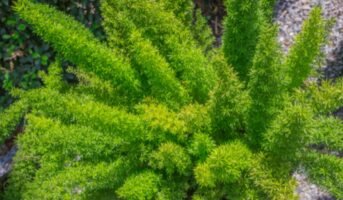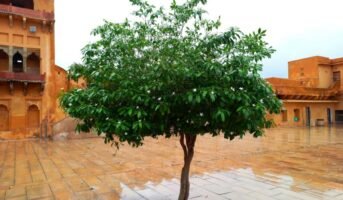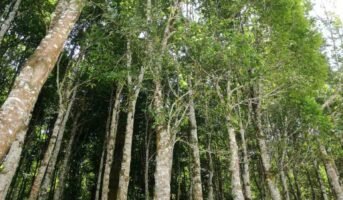A lovely, big, spreading deciduous tree with a dome-shaped crown is called Samanea saman. It was introduced to the Philippines during the American colonial era and has flourished admirably there, enhancing the beauty and comfort of our surroundings. The Samanea saman, or Rain tree, is well-known in the nation. Its characteristic umbrella-shaped canopy easily recognizes it.

Source: iStockphoto
see also about: giloy tree
Samanea Saman is one example of an evergreen tree you might grow in a yard or garden. It is a tropical and subtropical plant with rapid growth that has been used mainly for therapeutic purposes in gardens from ancient times. S. saman is primarily valuable for its hardwood but provides food, medicines, and gum. It is one of the most widely planted street and garden trees in the tropics and a shade tree for other crops. Let’s discover how to cultivate Samanea saman in your property and some of its possible advantages.
see also about: Groundnut plant
Samanea Saman: Facts
| Species Name | Samanea saman |
| Family Name | Fabaceae, legume family |
| Subfamily | Mimosoideae |
| Plant type | Autotrophic
Angiosperms (Flowering Seed Plants) Sub-Tropical/Monsoonal, Tropical, Evergreen Umbrella Shaped Terrestrial (Riverine) Deciduous Tree |
| Range of distribution | Northern S. America – Colombia, Venezuela; north through Central America to Nicaragua and El Salvador; Northeastern India, Sri Lanka India, Indochina, Indonesia, etc. |
| Other names | Rain tree, monkeypod, cow tamarind
Arbre de pluie, saman, zamang (Fr) Indonesia: trembesi, kayudan (Japanese), ki hujan (Sundanese) Malaysia: hujan-hujan, pukul lima Philippines: acacia Cambodia: ‘âmpül barang’ Thailand: kampu, chamchuri, chamcha Vietnam: me tây |
| Cultural/amenity | Impact- Positive |
| Human health | Impact- Positive |
| Uses | Both as a decorative plant and as a medicinal plant. |
| Temperature range | 50-90 F (10-32°C) |
| Best season for growth | Monsoon |
| Maintenance | Low |
Description of Samanea Saman
The Samanea saman is an attractive, wide-spreading perennial tree with a low, dense crown with a dome form and a usual height of 30 meters, while some specimens can arrive at 60 meters. It has a 200cm-diameter, short, naturally twisted bole. In humid climates, trees can remain evergreen.
- Flowers: 12–25 tiny blooms are arranged in pinkish heads 5–6 cm wide and around 4–5 cm tall, each having 12–25 blossoms. Both at once, thousands of leads are produced, enveloping the tree in a pinkish bloom. Each primary color head is larger, without a stalk, has more petals, and cannot bear fruit; instead, it bears a nectar-producing mechanism that entices insects.
- Leaves: Stipules are present and threadlike. The leaf blades are twice-effeminately compound, organized in 2-6 pairs of pinnae, each holding 6-16 diamond-shaped leaflets, brilliant green on top and drab and neatly haired below, 2-4 cm long and 1-2 cm wide, with the apical leaflets being the largest.
- Fruit: Grown pods are black-brown in color, rectangular, lumpy, 10-20 cm long, 15-19 mm broad, around 6 mm thick, linear or concave, not come as part but eventually split unevenly, and packed with a sticky, brownish pulp that is delicious.

Source: iStockphoto
How to grow Samanea Saman in your home?
- Propagation by seeds
Various simple ways to grow Samanea saman or rain trees exist. It can be multiplied by source (the traditional way), vertical stem cuttings, root cuttings, and stump cuttings. If one or more trees are required for residential use, seedlings are taken from the area of an existing tree and placed in the garden. Even big trees can be transplanted successfully with adequate care, significant root and top pruning, and other measures. Additionally, by offering them some weed control and protection, seedlings are encouraged to flourish where they sprout.
- Pre-planting seed treatments: Manual nicking off the seed coat with nail clippers or a tiny file works well, but it takes time. As an alternative, place the seed for 1–2 minutes in water that is 80°C (176°F) (water volume 5 times the seed volume). Then, the seeds should be stirred, drained, and soaked in lukewarm water (30–40°C; 86–104°F) for 24 hours. This approach produces 90-100% germination if defective seeds are removed before treatment.
- Germination: Three to five days after spreading scarified seeds, germination happens. Pre-treatment, while not required, results in equal germination and increases the proportion of seeds germinating.
- Media/containers: Seeds can be sown in the sand in nursery beds, in nursery mix (3 parts soil, 1-part sand, 1-part compost) in poly bags 10 x 20 cm (4 x 8 in), and directly in the field.
- Out planting: Seedlings are ready for transplanting 3-5 months after germination when they are 20-30 cm (8-12 in) tall. Strong stems are more significant than 10 mm (0.4 in) in diameter and help seedlings withstand wind and rain better. With aggressive weed management, survival and establishment after planting get better until the seedlings outgrow the surrounding vegetation and shade it.
Environmental preferences and tolerances of Samanea Saman

Source: iStockphoto
- Climate: The species has successfully established itself in various settings, including equatorial climates with year-round rainfall of 600–3000 mm (24–120 in) and monsoon climates with seasonal rain of 0–300 m.
- Soils: Samanea Saman may grow in various soil types and pH levels. It can survive in different light, medium, and heavy soil types. Also, raintree thrives on well-draining soils and may endure obstructed drainage. It can tolerate soggy soils temporarily in various circumstances. Rain trees are reported to flourish on raised land immediately inland from mangroves.
- Drought: Samanea Saman thrives in areas with a seasonal dry phase (2-4 months) and moisture circumstances with even rainfall distribution year-round. Long-term deficits are intolerable.
- Sunlight: The tree is a light-hungry plant. Its native habitat is Savannah grassland, seasonally dry deciduous woodland, and riverside forest corridors.
- Shade: Shade is intolerable to the rain tree. It is possible to cultivate seedlings in shady areas for up to four weeks until gradually moving them to full sun. Under dense stands of other trees, the seedlings cannot thrive. When rain trees are seen in mixed stands, they begin alongside or before the other species. Dense clumps of tall grasses like Guinea grass and elephant grass restrict and kill seedlings.
- Temperature: It grows from sea level to 1,500 m, with temperatures ranging from 18 to 22 °C in the coldest month to 24 to 30 °C in the hottest month, and it is intolerant to frost.
Samanea Saman: Growth and development
Raintree seedlings grow faster once established and can tolerate intense weed competition. However, if weeds are controlled until the saplings are taller than the adjacent grasses and herbaceous flora, the chances of survival and growth are boosted. Flowering starts early and is seasonal, starting at the end of the dry season, right after the leaves and mature pods fall off. Although blossoming is most common in the spring, trees can have flowers in practically any month of the year, especially in locations with year-round rainfall.
Samanea Saman: Properties

Source: istockphoto
Samanea saman, or the rain tree, has a few special abilities that can improve your garden’s environment and air quality. These properties are:
- Fix nitrogen: The rain tree fixes nitrogen through interaction with rhizobia bacterial strains (Bradyrhizobium). In addition, rain trees promote the development of grasses close to the tree canopy by enhancing the soil’s nitrogen content.
- Rapid regeneration: The rain tree has a large amount of seed production and reliable natural regeneration. Although predators destroy many seeds, there are so many generated that the following generation is guaranteed.
- Self-pruning: The tree often has strong side branches and a small bole. However, even in closely packed stands, lower limbs are frequently maintained.
Samanea Saman: Uses and products
Raintree has long been used as a source of lumber and livestock feed (green fodder and pods) for local use. There are also documented minor medical and artistic uses. For example, the seeds are hung on garlands, while the wood is used to carve things sold to tourists.
- Animal fodder: The pods are great to feed since they have 13–18% protein and are palatable and healthy for cattle. Raintree is cultivated as an additional source of green feed for cattle, lambs, and goats in Asia. A tree that is five years old can generate up to 550 kg of fresh feed.
- Beverage: A beverage resembling “tamarindo” (made from tamarind pulp) is prepared in Latin America using this fruit pulp.
- Medicinal: Many traditional medicines are made from different rain tree sections. For constipation relief, boiled bark is used as a poultice. An extract of the inner bark and fresh leaves is commonly used to treat diarrhea in the Philippines. Roots are made in a hot bath in Venezuela to treat stomach cancer. Chewing the seeds helps with sore throats in the West Indies.
- Timber: Wood is renowned for its usage in furniture, paneling, veneers, turnery, posts, boat-building framing, plywood, boxes, and crates. The sapwood is thin, white, or light cinnamon. The heartwood is straight or cross-grained, with a moderate to rough texture. Generally, it is a sturdy wood that can withstand attacks from dry wood termites.
- Agroforestry Uses: The tree was raised to offer shade for crops such as peppers, cocoa, coffee, and tea. Even in the low sun, the soft, dome-shaped crown casts a total amount of shadow. When it rains, the leaves fold up, letting more moisture reach the crops below.
- Edible Uses: The pods, which contain a brownish, gooey, liquor ice-like, sweet-flavored pulp, are consumed by kids. The pulp is also used to make a fruit beverage that tastes like lemon.
Why Samanea Saman is called Rain Tree?
In Malaysia, the drooping of the leaves of the tree are considered a sign of upcoming rain ergo the name Rain Tree. In India, it is believed that the name was given because the tree intermittently sprays moisture.
What are the uses of Rain Tree?
The wood of the tree is used primarily as fuel wood. The leaves and pods of rain tree are used as food due to the high nutritive content and nitrogen fixing capability.
What is special about Rain Tree?
The Rain Tree has medicinal properties such as antioxidants, antibacterial, anti-diabetic, analgesic, anti-ulcer, insecticidal, antifungal, and cytotoxic activities.
Is Samanea Saman native to Philippines or Singapore?
Samanea Saman is widely cultivated across Southeast Asia, especially Singapore.
Conclusion
For your outdoor area, the Samanea Saman plant is ideal. It has many positive qualities, including beauty, health benefits, ease of maintenance, quicker growth, etc. To add this tropical beauty to your indoor or backyard garden, you may acquire seeds or a little Samanea Saman plant from a nursery. Additionally, you can grow this plant from cuttings. You can also develop a rain tree bonsai on your balcony. Further, it reflects the historical and cultural traits of numerous local populations. Therefore, including this lovely plant in indoor or outdoor areas will be worthwhile.
FAQs
How long can this tree live?
Rain trees live an average of 80 to 100 years.
What are the main disadvantages of Samanea Saman?
Due to the shallow root system, the tree is also susceptible to windthrow during storm winds.
Which are the pests of this plant?
Ganoderma lucidum, wound parasites, has been identified in the Philippines. It can develop soft white decay in the lowest portion of the branch. Granular mildew, Erysiphe communis is persistent in greenhouses and can completely defoliate seedlings. The Leucaena psyllid grazes on immature shoots, causing defoliation, slowed node development, and, ultimately, tree mortality.
Why is it called a rain tree?
The leaflets are light-sensitive and close together on cloudy days (also from twilight to dawn), allowing rain to fall through the canopy to the ground below. That's why it is called a rain tree.
Housing News Desk is the news desk of leading online real estate portal, Housing.com. Housing News Desk focuses on a variety of topics such as real estate laws, taxes, current news, property trends, home loans, rentals, décor, green homes, home improvement, etc. The main objective of the news desk, is to cover the real estate sector from the perspective of providing information that is useful to the end-user.
Facebook: https://www.facebook.com/housing.com/
Twitter: https://twitter.com/Housing
Email: [email protected]











